 |
      |
| |
Biomass as source of energy
|
 |
Based on Eurostat records, bioenergy contributes to Europe's energy supply almost as much as the primary energy production of indigenous gas and more than that of oil.
In 2016, electricity generation from renewable sources contributed more than one quarter (29.6%) to total EU-28 gross electricity consumption. The growth in electricity generated from renewable energy sources during the period 2006 to 2016 largely reflects an expansion in three renewable energy sources across the EU, principally wind power, but also solar power and solid biofuels (including renewable wastes).
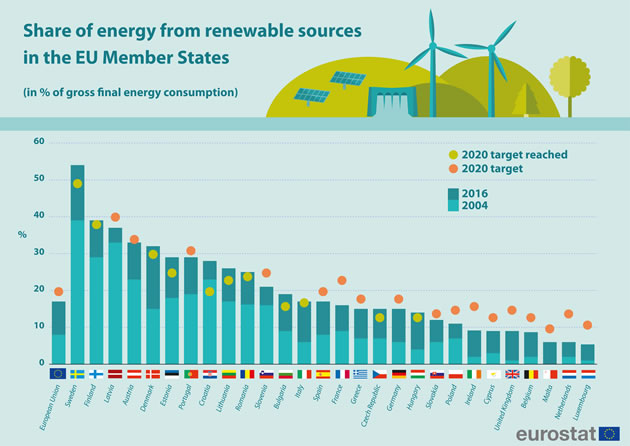
The bioenergy contribution for heating and cooling has currently the largest share (88%) of all RES used for heat and cooling with 76 Mtoe, quite close to the 2020 Member States plan of 90 Mtoe. Towards 2030 a moderate increase can be anticipated due to increased CHP deployment, together with the integration requirements of renewable electricity satisfied by bioenergy produced electricity and additional energy efficiency improvements of Europe's buildings.
The EU agreed to set a common target of 10% for the share of renewable energy (including liquid biofuels, hydrogen, biomethane, ‘green’ electricity, etc.) in the transport sector by 2020. The average share of energy from renewable sources in transport increased from 1.4% in 2004 to 7.1% in 2016. Concerning the use of renewable energy in transport, the most widely used energy source is derived from liquid biofuels, which are usually blended with fossil fuels. The figure below presents the evolution of the production of liquid biofuels in the European Union since 1990. Due to the binding 2020 target, the production of liquid biofuels in the EU has increased significantly, with biodiesel the bioethanol most widely produced, followed by biogasoline and other liquid biofuels. In the future European Union aims to rely mostly on advanced biofuels, waste-based fuels and renewable electricity with a target set at 6.8% for 2030, including at least 3.6% in the form of advanced biofuels.
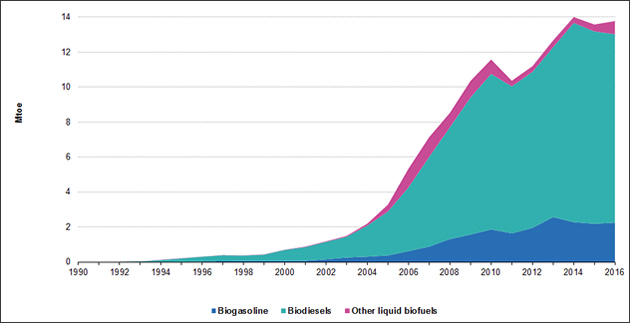
Primary production of liquid biofuels EU-28 1990-2016 (Source: Eurostat)
How to turn technological challenges into social opportunities
|
 |
How far bioenergy can further contribute to the energy mix strongly depends on cost and availability of sustainable biomass. The main challenge is the development of reliable, integrated biomass supply chains from cultivation, harvesting, transport, storage to conversion and by-product use. Secure, long-term supply of sustainable feedstock – often by local supply chains - is essential to the economics of bioenergy.
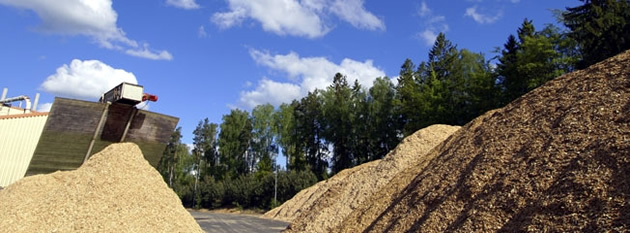
In addition, given different origin and quite different physical properties of biomass, many different technologies have been developed to convert biomass to the final energy product. The cost of feedstock accounts for around 50% of bioenergy system costs. For those reasons, EU research and innovation (R&I) support is directed at:
-
reducing these costs;
-
diversifying the feedstock possibilities;
-
increasing the overall efficiency of the heat and power cogeneration.
This paves the way for reducing costs of the final bioenergy products.
The European Commission has set out several energy strategies for a more secure, sustainable and low-carbon economy. Aside from combatting climate change through a reduction in greenhouse gas emissions, the use of renewable energy sources is likely to result in more secure energy supplies, greater diversity in energy supply, less air pollution, as well as the possibility for job creation in environmental and renewable energy sectors.
The SET Plan actions for bioenergy
|
 |
As stated in the Second Report on the State of the Energy Union, the modernisation of Europe’s economy requires effective competition and a stable regulatory framework in the energy markets to encourage innovation and competitiveness. The Communication "Accelerating Clean Energy Innovation" presents a European Union strategy to enable European companies and new businesses to boost research and innovation in clean energy solutions and should ensure that their results are quickly and successfully brought to the marketplace. Considerable progress was made in all of the priority areas of the Strategic Energy Technology (SET) Plan which has the aim to integrate cost-efficient low-carbon technologies into the energy system.
One of the core priorities of the Energy Union Strategy is to speed up the energy efficiency and decarbonisation of transport through research and innovation in e-mobility and in renewable fuels. Electric vehicles (EVs) will play a major role in meeting Europe's need for clean and efficient mobility. In addition, the goals for the decarbonisation of transport will also require significant volumes of advanced biofuels from sustainable sources.
|
|
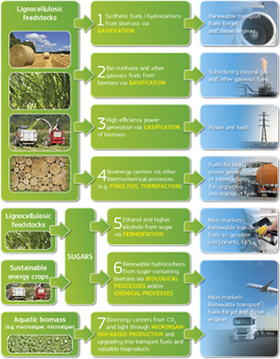
European Bioenergy Industrial Initiative Value Chains (Source: SETIS)
|
The SET Plan constituency has identified the need for bioenergy R&I in seven related sustainable value chains.
This will create a new market for European-produced advanced renewable fuels.
In the same vein, concerted efforts are required for efficient management of biomass resources and the upgrading of fuel quality, with particular emphasis on agricultural, municipal and industrial residues, along with waste streams and energy crops grown on degraded land. Innovative system for integration via bio-refineries should maximise the use of sustainable resources. The overall focus of the targets is on cost reduction, improvement of conversion efficiency and on meeting sustainability goals.
“Innovation and Integration” in the conference sessions
|
 |
The 2030 climate and energy framework refers to the need to monitor technological innovation (R&I expenditure, EU patents, competitivity of technologies compared with other non-EU countries).
The transition to a low-carbon economy requires the development and implementation of new technologies, as they have been prioritised in the research, innovation and competitiveness dimension of the Energy Union. Innovation is key to the success of decarbonisation, starting with R&I investments.
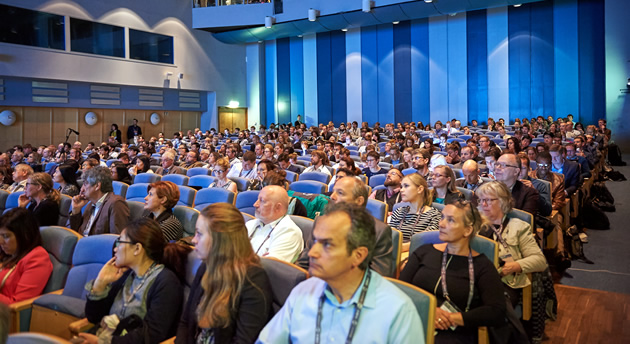
The challenges and opportunities arising from the implementation of new technologies are addressed in Wednesday Plenary Session:
CP.1 Innovation and Integration, Wednesday, 16 May 2018, 10:15-12:35
This session starts with an overview on energy crop potentials in the USA, addresses recent advances in innovative technologies that are having a significant impact in the fields of biorefining, pyrolysis, hydrothermal liquefaction and biomass combustion, as well as provides examples of technology integration and bio-products, including drop-in fuels, biomethane and hydrogen.
Sustainability is the key issue determining future developments in bioenergy, depending largely on the availability of sustainable biomass.
The challenges and opportunities arising from the sustainable use of biomass for mitigating climate impacts are addressed in Tuesday Plenary Session:
BP.1: Climate and Sustainability
This session includes reviews of lessons learned from LCA, ILUC mitigation and climate benefits from bioenergy in agriculture and forestry, as well as sustainability governance and socio-economic impacts of support provided to biofuels.
Many other conference sessions, both oral and visual, and hosted events will discuss the themes related to biomass use and management suitable for enhancing the penetration and integration of variable renewable energy sources on power grids and power generation systems. In addition, several contributions will present new process technologies and strategies that have been proposed to produce biobased chemicals from biomass. In the Industry sessions, developments of conversion processes and systems for biomass will be industrially and commercially approached.
   
More information on www.eubce.com
|
|
|
|
|
|
|
|
|
|
|
|
|
|
|
|
|
|
|
| |
INSTITUTIONAL BIOMASS INDUSTRY COOPERATION
|
|
|
|
|
|
|
|
|
|
|
|
|
|
|
|
|
|
|
|
|
|
|
|
|
| |
Organised by
|
with the support of
|
|
|
|
|
|
|






